Today is the opening of the exhibition Alma-Tadema, At Home in Antiquity at the Fries Museum in Leeuwarden, The Netherlands. The Dutch-born painter Sir Lawrence Alma-Tadema (1836-1912) was the most successful and seductive storyteller of his day. He accomplished this by an innovative use of space in his work. Through his great knowledge of archaeology and classical antiquity he managed to bring the days of ancient Rome to life in paintings. His scenes were received so enthusiastically all over the world that our present image of classical antiquity was influenced by them. In the European cinema and in Hollywood too, Alma-Tadema’s interpretation caught on and became the basis for seminal films about this era, from the Italian epics of the 1910s to Ridley Scott's Gladiator (2000).Today 12 postcards about films, inspired by the work of this remarkable artist, who probably had been a filmmaker had he lived later.
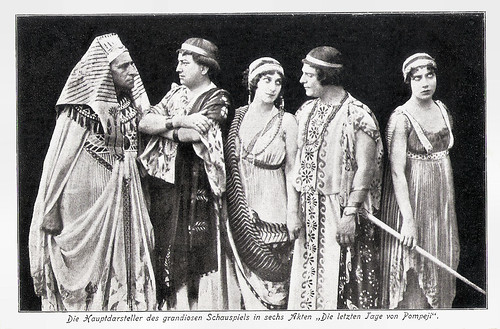
German postcard by Rodera-Lichtspiele, Dresden, 1913. Publicity still for the Italian silent epic Gli ultimi giorni di Pompei/The Last Days of Pompeii (Eleuterio Rodolfi, 1913). From left to right: Antonio Grisanti as Arbaces, the Egyptian High Priest of Isis; Cesare Gani Carini as Apecides, a disciple of Arbaces and the brother of Jone; Eugenia Tettoni Fior as Jone; Ubaldo Stefani as Glaucus, Jone's lover; and Fernanda Negri Pouget as the blind slave Nidia. The film was produced by Società Anonima Ambrosio.
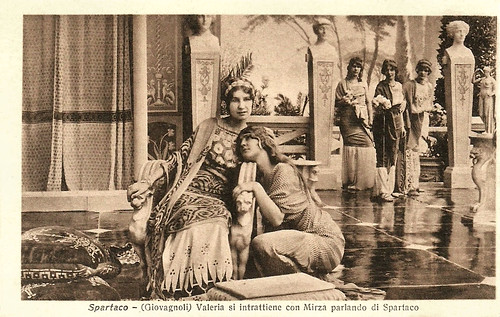
Italian postcard. Photo: publicity still for Spartaco (Enrico Vidali, 1913). Caption: Valeria si intrattiene con Mirza parlando di Spartaco (Valeria sits with Mirza, talking about Spartacus). Spartaco's sister Mirza (Cristina Ruspoli) has become the slave of Crassus' daughter Valeria (Maria Gandini). Valeria becomes interested in Spartacus because of what Mirza tells about him. In other versions Mirza is called Idamis, and Valeria Elena.
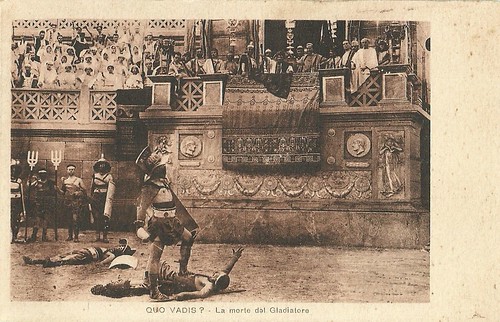
Italian postcard Photo: Cines. Publicity still for the early epic Quo vadis? (Enrico Guazzoni, 1913), adapted from Henryk Sienkiewicz's classic novel and the biggest film hit of 1913 worldwide. Caption: The death of the gladiator. This image cites Jean-Léon Gérôme's famous painting Pollice verso (Thumbs down, 1872) and was often used in the publicity for the film. In the back the emperor Nero (Carlo Cattaneo) makes the sign of thumbs down, sign for the conqueror to kill his adversary. Flanking Nero are left Tigellinus (Cesare Moltini) and right Petronius (Gustavo Serena). Left of the imperial box the Vestal Virgins are seated.
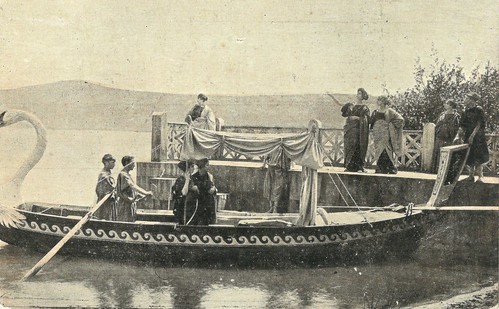
Spanish postcard for Amatller Marca Luna Chocolate, Series 8. Photo: Palatino Film. Elena Sangro as Fabiola and signora Poletti as her niece Agnese in Enrico Guazzoni's Fabiola (1918). When the persecutions of the Christians in Rome become too rough, Fabiola takes her niece Agnese to her villa in the countryside.
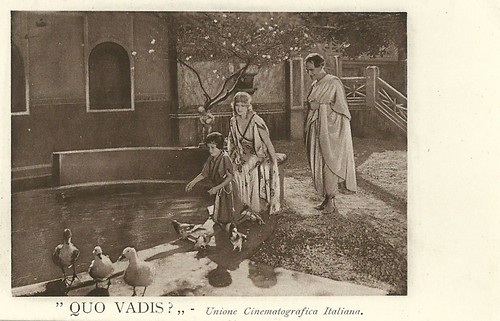
Italian postcard by Edizione L'Argentografica, Torino. Publicity still for the Italo-German epic Quo Vadis? (Gabriellino D'Annunzio, Georg Jacoby, 1924), one of the many adaptations of the classic novel by Henryk Sienkiewicz, with Lilian Hall-Davis as Licia.

German postcard by Ross-Verlag, Berlin, no. 699/6, 1919-1924. Photo: Filmhaus Brückmann. Publicity still for Quo Vadis? (Gabriellino D'Annunzio, Georg Jacoby, 1924) with Rina De Liguoro.
Sir Lawrence Alma-Tadema's painted scenes appeal to the imagination and are totally convincing. Even though we may not be aware of it, our picture of Roman antiquity has been largely defined by Alma-Tadema.
The exhibition explores how this came to be by very closely following Alma-Tadema’s personal life and artistic career.
No one could paint as convincingly as Alma-Tadema, so it is hardly surprising that Cinecittá and Hollywood were only too eager to convert his paintings into moving images for their Roman spectacles.
From the silent era on, film directors were after all looking for a visual language for the new mass medium of film and Alma-Tadema provided them with the blueprint for it. And this continues on to this day.
Director Ridley Scott studied Alma-Tadema when making his successful films Gladiator (2000) and Exodus (2014). Scott’s production designer, Arthur Max, sees Alma-Tadema as someone who shows us Rome as we want it to look like, not necessarily as it really was.
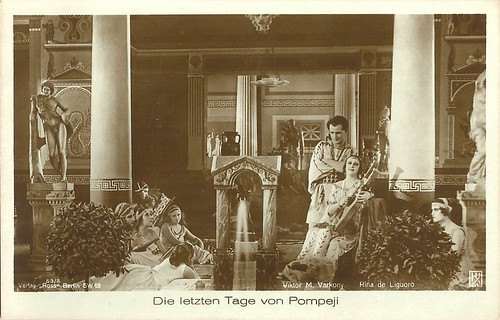
German postcard by Ross Verlag, no. 53/2. Photo: Hisa. Publicity still for the Italian silent epic Gli ultimi giorni di Pompei/The Last Days of Pompeii (Carmine Gallone, Amleto Palermi, 1926). The film was based on the 1834 novel The Last Days of Pompeii by Edward Bulwer-Lytton. On the photo, Glaucus (Victor Varconi) listens to beautiful and rich Greek Ione (Rina De Liguoro) playing the harp. The statue left was copied from an original Roman one.
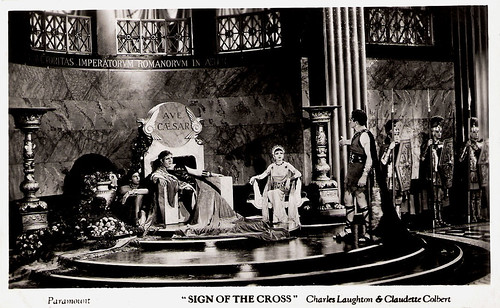
British postcard in the series Film Shots by Film Weekly. Photo: Paramount. Publicity still of The Sign of the Cross (Cecil B. De Mille, 1932) with Claudette Colbert and Charles Laughton.
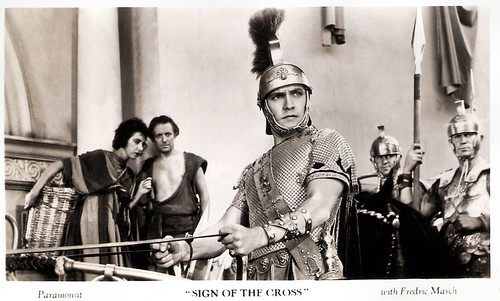
British postcard in the series Film Shots by Film Weekly. Photo: Paramount. Publicity still for The Sign of the Cross (Cecil B. De Mille, 1932) with Fredric March.
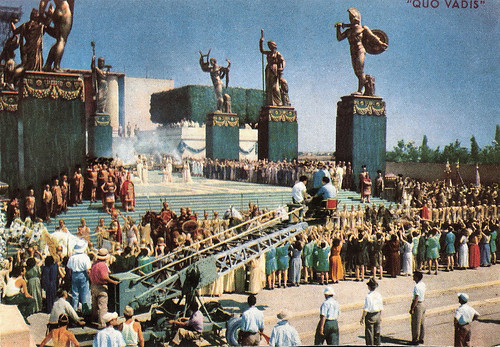
Italian postcard by A. Mondadori, Verona. Publicity still for Quo Vadis (Mervyn LeRoy, Anthony Mann, 1951). Caption: In Rome, Italy, Technicolor cameras film a scene for M.G.M.'s Quo Vadis. Roman soldiers parade before Nero's palace here.
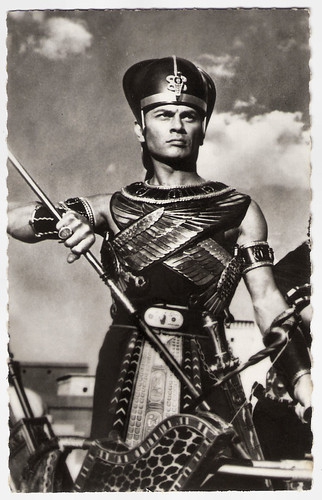
French postcard by Editions P.I., Paris, no. 831, 1956. Photo: Paramount Pictures Inc. Yul Brynner as Ramses in The Ten Commandments (Cecil B. DeMille, 1956).
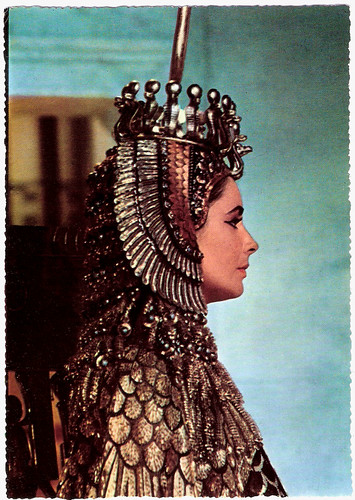
Belgian postcard by SB (Uitgeverij Best), Antwerpen (Antwerp). Photo: still for Cleopatra (Joseph L. Mankiewicz, 1963) with Elizabeth Taylor.
Alma-Tadema in film. Source: Fries Museum (YouTube).
Sources: Fries Museum and Eye.

German postcard by Rodera-Lichtspiele, Dresden, 1913. Publicity still for the Italian silent epic Gli ultimi giorni di Pompei/The Last Days of Pompeii (Eleuterio Rodolfi, 1913). From left to right: Antonio Grisanti as Arbaces, the Egyptian High Priest of Isis; Cesare Gani Carini as Apecides, a disciple of Arbaces and the brother of Jone; Eugenia Tettoni Fior as Jone; Ubaldo Stefani as Glaucus, Jone's lover; and Fernanda Negri Pouget as the blind slave Nidia. The film was produced by Società Anonima Ambrosio.

Italian postcard. Photo: publicity still for Spartaco (Enrico Vidali, 1913). Caption: Valeria si intrattiene con Mirza parlando di Spartaco (Valeria sits with Mirza, talking about Spartacus). Spartaco's sister Mirza (Cristina Ruspoli) has become the slave of Crassus' daughter Valeria (Maria Gandini). Valeria becomes interested in Spartacus because of what Mirza tells about him. In other versions Mirza is called Idamis, and Valeria Elena.

Italian postcard Photo: Cines. Publicity still for the early epic Quo vadis? (Enrico Guazzoni, 1913), adapted from Henryk Sienkiewicz's classic novel and the biggest film hit of 1913 worldwide. Caption: The death of the gladiator. This image cites Jean-Léon Gérôme's famous painting Pollice verso (Thumbs down, 1872) and was often used in the publicity for the film. In the back the emperor Nero (Carlo Cattaneo) makes the sign of thumbs down, sign for the conqueror to kill his adversary. Flanking Nero are left Tigellinus (Cesare Moltini) and right Petronius (Gustavo Serena). Left of the imperial box the Vestal Virgins are seated.

Spanish postcard for Amatller Marca Luna Chocolate, Series 8. Photo: Palatino Film. Elena Sangro as Fabiola and signora Poletti as her niece Agnese in Enrico Guazzoni's Fabiola (1918). When the persecutions of the Christians in Rome become too rough, Fabiola takes her niece Agnese to her villa in the countryside.

Italian postcard by Edizione L'Argentografica, Torino. Publicity still for the Italo-German epic Quo Vadis? (Gabriellino D'Annunzio, Georg Jacoby, 1924), one of the many adaptations of the classic novel by Henryk Sienkiewicz, with Lilian Hall-Davis as Licia.

German postcard by Ross-Verlag, Berlin, no. 699/6, 1919-1924. Photo: Filmhaus Brückmann. Publicity still for Quo Vadis? (Gabriellino D'Annunzio, Georg Jacoby, 1924) with Rina De Liguoro.
Alma-Tadema defined our picture of Roman antiquity
Sir Lawrence Alma-Tadema's painted scenes appeal to the imagination and are totally convincing. Even though we may not be aware of it, our picture of Roman antiquity has been largely defined by Alma-Tadema.
The exhibition explores how this came to be by very closely following Alma-Tadema’s personal life and artistic career.
No one could paint as convincingly as Alma-Tadema, so it is hardly surprising that Cinecittá and Hollywood were only too eager to convert his paintings into moving images for their Roman spectacles.
From the silent era on, film directors were after all looking for a visual language for the new mass medium of film and Alma-Tadema provided them with the blueprint for it. And this continues on to this day.
Director Ridley Scott studied Alma-Tadema when making his successful films Gladiator (2000) and Exodus (2014). Scott’s production designer, Arthur Max, sees Alma-Tadema as someone who shows us Rome as we want it to look like, not necessarily as it really was.

German postcard by Ross Verlag, no. 53/2. Photo: Hisa. Publicity still for the Italian silent epic Gli ultimi giorni di Pompei/The Last Days of Pompeii (Carmine Gallone, Amleto Palermi, 1926). The film was based on the 1834 novel The Last Days of Pompeii by Edward Bulwer-Lytton. On the photo, Glaucus (Victor Varconi) listens to beautiful and rich Greek Ione (Rina De Liguoro) playing the harp. The statue left was copied from an original Roman one.

British postcard in the series Film Shots by Film Weekly. Photo: Paramount. Publicity still of The Sign of the Cross (Cecil B. De Mille, 1932) with Claudette Colbert and Charles Laughton.

British postcard in the series Film Shots by Film Weekly. Photo: Paramount. Publicity still for The Sign of the Cross (Cecil B. De Mille, 1932) with Fredric March.

Italian postcard by A. Mondadori, Verona. Publicity still for Quo Vadis (Mervyn LeRoy, Anthony Mann, 1951). Caption: In Rome, Italy, Technicolor cameras film a scene for M.G.M.'s Quo Vadis. Roman soldiers parade before Nero's palace here.

French postcard by Editions P.I., Paris, no. 831, 1956. Photo: Paramount Pictures Inc. Yul Brynner as Ramses in The Ten Commandments (Cecil B. DeMille, 1956).

Belgian postcard by SB (Uitgeverij Best), Antwerpen (Antwerp). Photo: still for Cleopatra (Joseph L. Mankiewicz, 1963) with Elizabeth Taylor.
Alma-Tadema in film. Source: Fries Museum (YouTube).
Sources: Fries Museum and Eye.
No comments:
Post a Comment